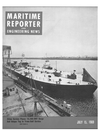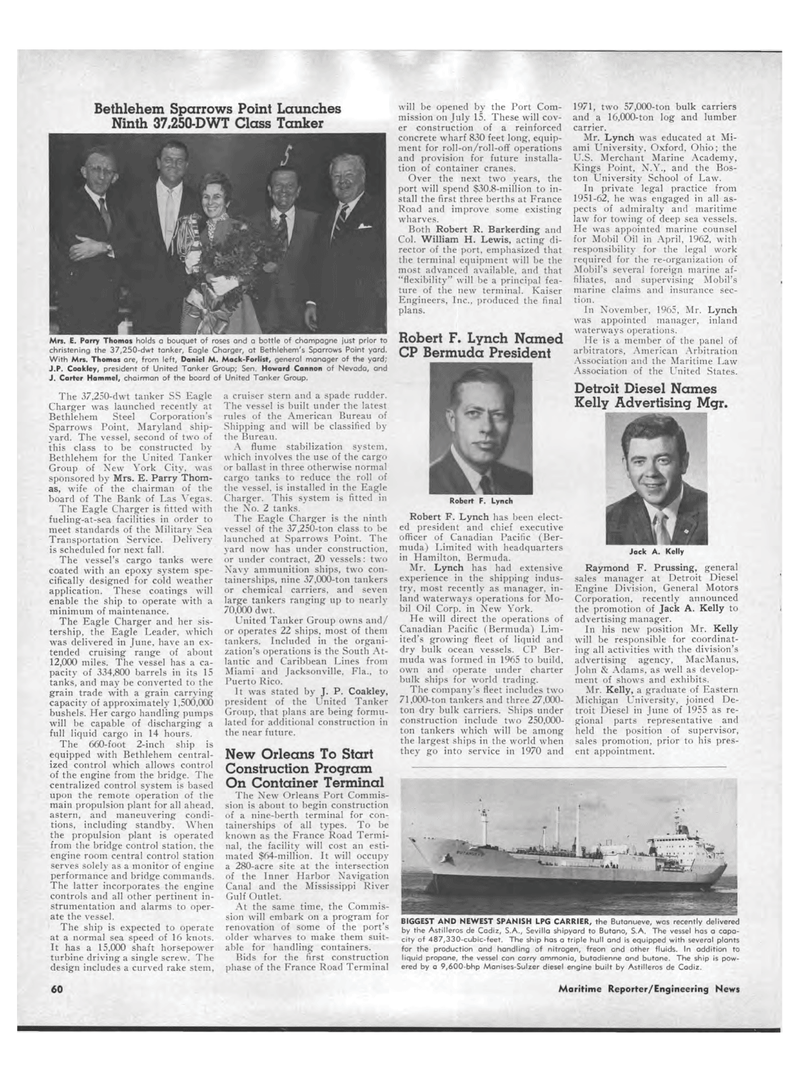
Page 56: of Maritime Reporter Magazine (July 15, 1969)
Read this page in Pdf, Flash or Html5 edition of July 15, 1969 Maritime Reporter Magazine
Bethlehem Sparrows Point Launches Ninth 37,250-DWT Class Tanker Mrs. E. Parry Thomas holds a bouquet of roses and a bottle of champagne just prior to christening the 37,250-dwt tanker, Eagle Charger, at Bethlehem's Sparrows Point yard. With Mrs. Thomas are, from left, Daniel M. Mack-Forlist, general manager of the yard; J.P. Cookley, president of United Tanker Group; Sen. Howard Cannon of Nevada, and J. Carter Hammel, chairman of the board of United Tanker Group. The 37,250-dwt tanker SS Eagle Charger was launched recently at Bethlehem Steel Corporation's Sparrows Point, Maryland ship-yard. The vessel, second of two of this class to be constructed by Bethlehem for the United Tanker Group of New York City, was sponsored by Mrs. E. Parry Thom-as, wife of the chairman of the board of The Bank of Las Vegas. The Eagle Charger is fitted with fueling-at-sea facilities in order to meet standards of the Military Sea Transportation Service. Delivery is scheduled for next fall. The vessel's cargo tanks were coated with an epoxy system spe-cifically designed for cold weather application. These coatings will enable the ship to operate with a minimum of maintenance. The Eagle Charger and her sis-tership, the Eagle Leader, which was delivered in June, have an ex-tended cruising range of about 12,000 miles. The vessel has a ca-pacity of 334,800 barrels in its 15 tanks, and may be converted to the grain trade with a grain carrying capacity of approximately 1,500.000 bushels. Her cargo handling pumps will be capable of discharging a full liquid cargo in 14 hours. The 660-foot 2-inch ship is equipped with Bethlehem central-ized control which allows control of the engine from the bridge. The centralized control system is based upon the remote operation of the main propulsion plant for all ahead, astern, and maneuvering condi-tions, including standby. When the propulsion plant is operated from the bridge control station, the engine room central control station serves solely as a monitor of engine performance and bridge commands. The latter incorporates the engine controls and all other pertinent in-strumentation and alarms to oper-ate the vessel. The ship is expected to operate at a normal sea speed of 16 knots. It has a 15,000 shaft horsepower turbine driving a single screw. The design includes a curved rake stem, a cruiser stern and a spade rudder. The vessel is built under the latest rules of the American Bureau of Shipping and will be classified by the Bureau. A flume stabilization system, which involves the use of the cargo or ballast in three otherwise normal cargo tanks to reduce the roll of the vessel, is installed in the Eagle Charger. This system is fitted in the No. 2 tanks. The Eagle Charger is the ninth vessel of the 37,250-ton class to be launched at Sparrows Point. The yard now has under construction, or under contract, 20 vessels: two Navy ammunition ships, two con-tainerships, nine 37,000-ton tankers or chemical carriers, and seven large tankers ranging up to nearly 70,000 dwt. United Tanker Group owns and/ or operates 22 ships, most of them tankers. Included in the organi-zation's operations is the South At-lantic and Caribbean Lines from Miami and Jacksonville, Fla., to Puerto Rico. It was stated by J. P. Coakley, president of the United Tanker Group, that plans are being formu-lated for additional construction in the near future. New Orleans To Start Construction Program On Container Terminal The New Orleans Port Commis-sion is about to begin construction of a nine-berth terminal for con-tainerships of all types. To be known as the France Road Termi-nal, the facility will cost an esti-mated $64-million. It will occupy a 280-acre site at the intersection of the Inner Harbor Navigation Canal and the Mississippi River Gulf Outlet. At the same time, the Commis-sion will embark on a program for renovation of some of the port's older wharves to make them suit-able for handling containers. Bids for the first construction phase of the France Road Terminal will be opened by the Port Com-mission on July 15. These will cov-er construction of a reinforced concrete wharf 830 feet long, equip-ment for roll-on/roll-off operations and provision for future installa-tion of container cranes. Over the next two years, the port will spend $30.8-million to in-stall the first three berths at France Road and improve some existing wharves. Both Robert R. Barkerding and Col. William H. Lewis, acting di-rector of the port, emphasized that the terminal equipment will be the most advanced available, and that "flexibility" will be a principal fea-ture of the new terminal. Kaiser Engineers, Inc., produced the final plans. Robert F. Lynch Named CP Bermuda President Robert F. Lynch Robert F. Lynch has been elect-ed president and chief executive officer of Canadian Pacific (Ber-muda) Limited with headquarters in Hamilton, Bermuda. Mr. Lynch has had extensive experience in the shipping indus-try, most recently as manager, in-land waterways operations for Mo-bil Oil Corp. in New York. He will direct the operations of Canadian Pacific (Bermuda) Lim-ited's growing fleet of liquid and dry bulk ocean vessels. CP Ber-muda was formed in 1965 to build, own and operate under charter bulk ships for world trading. The company's fleet includes two 71,000-ton tankers and three 27.000-ton dry bulk carriers. Ships under construction include two 250,000-ton tankers which will be among the largest ships in the world when they go into service in 1970 and 1971, two 57,000-ton bulk carriers and a 16,000-ton log and lumber carrier. Mr. Lynch was educated at Mi-ami University, Oxford, Ohio; the U.S. Merchant Marine Academy, Kings Point, N.Y., and the Bos-ton University School of Law. In private legal practice from 1951-62, he was engaged in all as-pects of admiralty and maritime law for towing of deep sea vessels. He was appointed marine counsel for Mobil Oil in April, 1962, with responsibility for the legal work required for the re-organization of Mobil's several foreign marine af-filiates, and supervising Mobil's marine claims and insurance sec-tion. In November, 1965, Mr. Lynch was appointed manager, inland waterways operations. He is a member of the panel of arbitrators, American Arbitration Association and the Maritime Law Association of the United States. Detroit Diesel Names Kelly Advertising Mgr. Jack A. Kelly Raymond F. Prussing, general sales manager at Detroit Diesel Engine Division, General Motors Corporation, recently announced the promotion of Jack A. Kelly to advertising manager. In his new position Mr. Kelly will be responsible for coordinat-ing all activities with the division's advertising agency, MacManus, John & Adams, as well as develop-ment of shows and exhibits. Mr. Kelly, a graduate of Eastern Michigan University, joined De-troit Diesel in June of 1955 as re-gional parts representative and held the position of supervisor, sales promotion, prior to his pres-ent appointment. BIGGEST AND NEWEST SPANISH LPG CARRIER, the Butanueve, was recently delivered by the Astilleros de Cadiz, S.A., Sevilla shipyard to Butano, S.A. The vessel has a capa-city of 487,330-cubic-feet. The ship has a triple hull and is equipped with several plants for the production and handling of nitrogen, freon ond other fluids. In addition to liquid propane, the vessel con carry ammonia, butadienne and butane. The ship is pow-ered by a 9,600-bhp Manises-Sulzer diesel engine built by Astilleros de Cadiz. 60 Maritime Reporter/Engineering News

 55
55

 57
57
